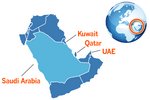Historical/Ancient Sites in Saudi Arabia
By: Cynthia Piccolo
 While I was visiting Saudi Arabia years ago, I had an interesting conversation with a Saudi man. He told me how the mosque in his hometown in the northwestern part of the Kingdom had, many centuries ago, been a Christian church, and even earlier than that, had been a synagogue. As a child, he would play around town and around the mosque, and had collected a box full of pottery shards, arrowheads, and even a few coins. Then, when he went off to university, his mother cleaned his room and threw them all away. From this, I learned not only that mothers are the same everywhere, but also that history is in danger of being lost. This may be particularly true in a country, such as Saudi Arabia, that, within just the past few decades, has advanced very quickly into the modern world. A May 2, 2007 article in the Arab News quoted Dr. Mohammed Al-Ruwaished, deputy minister of education for antiquities and museums, as saying there are nearly 100,000 historical sites in the Kingdom, 3,700 of which have already been identified and registered. Here are the better known ones: Mecca Mecca is the holiest city in Islam. It attracts millions of Muslims each year, especially for the Hajj pilgrimage (one of the Five Pillars of Islam). The city, which reportedly dates back more than 4,000 years, is forbidden to non-Muslims. Mecca is the home to historical landmarks such as the Kaaba, the cube structure within the Grand Mosque, which Muslims believe was built by Abraham and his son Ishmael. The Grand Mosque is also the site of the ancient Zamzam Well, located meters from the Kaaba, and which is also believed to be connected to Ishmael. Medina Medina's history dates back more than 2,600 years. It is the second-holiest city in Islam, and is the burial place of the prophet Mohammed. Medain Saleh ("Cities of Saleh") History buffs — particularly Middle Eastern history buffs — are most familiar with the stone city of Petra, in Jordan. Petra was carved out of the rocks in a tall canyon by an ancient Semitic people known as the Nabateans. The city was built in a defensible place with access to water, and along the caravan routes. Many miles southeast of Petra, in Saudi Arabia, is Medain Saleh. Medain Saleh is the largest conserved site, south of Petra, of the civilization of the Nabataeans. Featuring well-preserved monumental tombs with decorated facades dating from the 1st century BC to the 1st century AD, the site also has cave inscriptions dating to a much earlier period. In total, it has 111 tombs, of which 94 are decorated. Medain Saleh gained UNESCO World Heritage status in 2008, making it Saudi Arabia's first World Heritage Site. Due to the limited tourism in Saudi Arabia, this is an archaeological treasure that few have seen. Jubba Paleolithic Kingdom Located near the small town of Jubba (100 km, or 62 miles northwest of Hail), visitors can see rock art depicting animals and people dating back 7,000 years. If you can't get out that far, some examples of the art have been transported to the National Museum in Riyadh. Old Dariyah Not nearly so old, yet still worth a see, is Old Dariyah. Located a short drive outside Riyadh, it is the home village of the ruling family of Saudi Arabia. Although most of the mud buildings date to this century, Old Dariyah is several centuries old, with the oldest section dating to the 9th century. Najran's Traditional Architecture For a look at some traditional architecture, head to Najran in southwestern Saudi Arabia near the border with Yemen, to see the traditional adobe and brick architectural style, known as the midmakh buildings. Some of the community's buildings are estimated to be several hundred years old. Old Jeddah Today, Jeddah is a cosmopolitan, modern city, but it still has its jewels (although not ancient ones). The old city of Jeddah (Al-Balad) traces its origins back more than 2,500 years ago when Jeddah was a small fishing village. Today, in the heart of modern Jeddah you will see beautifully renovated old houses, which date to the late 1800s as well as preserved examples of traditional architecture styles with intricately carved doors and the lattice-work screens, which allow the sea breezes in, but keep out the sun). Finally ... And there are also lesser-known, or less obvious sites. While in Saudi Arabia our hosts, who work at the King Faisal Specialist Hospital, Jeddah, took us on a day trip from Jeddah to Taif. They drove a very short distance off the highway towards some cylindrical stone structures, each about six feet (two meters) tall. It turns out these were part of a chain of 1,000-year-old water cisterns, built by a princess to provide water to Mecca from a source in the mountains. As people drove by going about their business, I wondered if they even knew about the unassuming treasure just off the highway. Most Popular |
Related |
Copyright (C) 2025 Helen Ziegler and Associates. All rights reserved.




